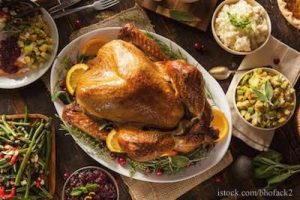The USDA is sharing tips for making a safe and delicious Thanksgiving dinner. USDA Under Secretary for Food Safety Dr. Elisabeth Hagen said, “all year, Americans look forward to sharing a Thanksgiving meal with family and friends, and USDA wants to make sure that meal is safe as well as delicious. We encourage hosts to take advantage of our resources, like the USDA Meat and Poultry Hotline (888-674-6854), if they have any questions about how to safely cook, store, and serve food for guests.”
 The hotline is open from 8:00 am to 2:00 pm ET on Thanksgiving day. the FSIS virtual food safety representative, Ask Karen, is available 24/7 in English and Spanish. The timeline for preparing the Thanksgiving meal follows.
The hotline is open from 8:00 am to 2:00 pm ET on Thanksgiving day. the FSIS virtual food safety representative, Ask Karen, is available 24/7 in English and Spanish. The timeline for preparing the Thanksgiving meal follows.
One week before Thanksgiving, get your frozen turkey ready to cook. It takes days for a frozen turkey to safely thaw in the refrigerator. Leave the bird in its original wrapper and place it on a tray or large roasting pan to make sure no juices leak from the turkey and cross-contaminate other foods. Allow 24 hours for every four or five pounds of turkey. A thawed turkey and a turkey purchased fresh can stay safely in the fridge for one to two days before cooking. Or, cook the turkey frozen! That’s how I cook my Thanksgiving bird.
Two days before Thanksgiving, choose your stuffing method. Food safety experts recommend that you cook the turkey unstuffed, since the center of the stuffing may not reach the safe food temperature of 165 degrees F. If you check the stuffing with a reliable food thermometer, you can stuff the bird, but if anyone in your family is in a high risk group (very young, elderly, compromised immune systems), you may want to bake the stuffing outside of the turkey. I like to make my stuffing in a crockpot, which replicates the moist heat of the turkey interior. You can prepare the wet and dry ingredients for stuffing ahead of time, but do not mix them until it’s time to cook.
On Thanksgiving Day, always cook the turkey at 325 degrees F or a higher temperature. Lower temperatures are not safe. Make sure that the turkey and the stuffing reach a minimum temperature of 165 degrees F to avoid foodborne illness. Some of the turkey meat may remain pink. That’s okay, as long as that temperature of 165 degrees F is reached. When you take the turkey’s temperature, be sure that the probe is not touching bone or the reading will be incorrect.
After dinner, be sure to chill all leftovers as soon as possible. Cut the turkey into smaller pieces, place in shallow containers, and refrigerate within two hours of cooking. Refrigerated leftovers can be used with three to four days. After four days, freeze leftovers in a labeled freezer container. Always reheat leftovers to 165 degrees before eating.
If you plan on cooking other meats for the holiday, the USDA’s Food Safety and Inspection Service has lots of fact sheets with good information. Have a wonderful Thanksgiving!




